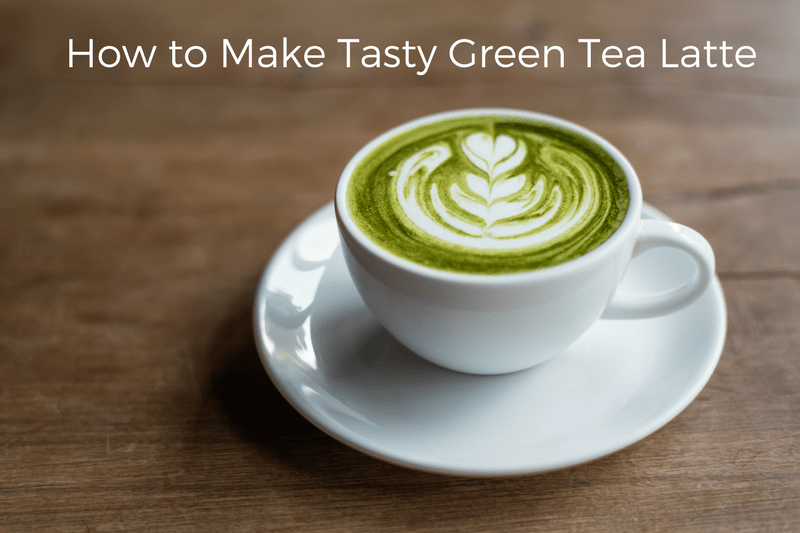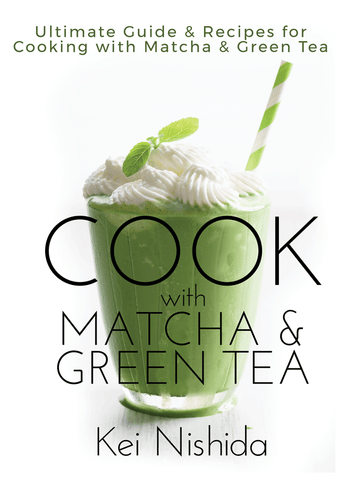Everything You Need To Know About Different Types of Japanese Tea

The world of Japanese Green Tea is wide and wonderful, but it is sometimes confusing with all the terms used.
There are more than 100 total types of Japanese green tea names being used today. Names can refer to not the only type of tea, but they can also indicate which part of the tea plant is used, what kind of processing method was used, the name of the location where tea is farmed, etc.
For instance, the sencha you are drinking may be of type Yabukita cultivar, deeply steamed (fukamushi-cha) and grown in Shizuoka (shizuoka-cha) and could consist only of steam of tea plant called Kuki-cha.
Confused?
Below is a helpful list which breaks up all commonly used Japanese green tea names in a simpler grouping so that you can learn the differences and enjoy the journey of different type of Japanese green tea!
Since there are so many type of tea covered in this article, I have added a quick link list.
Click on tea type you want from this list or scroll down to read all.
Most Commonly Known Japanese Tea Type
Tea Type Based on Part of Tea Plant
Tea Type Based on Covering Process
Tea Type Based on Season of Crop
- Ichiban-cha (First Crop Tea):一番茶
- Shin-cha: 新茶
- Niban-cha: 二番茶
- Sanban-cha: 三番茶
- Bancha (Coarse Tea): 番茶
Tea Type of Powder Tea
Tea Type Based on Length of Steaming
- Fukamushi-cha (Deep Steam Tea):深蒸し茶
- Asamushi-cha (Light Steam Tea): 浅蒸し茶
- Futsumuch or Namamushi (Medium Steamed Tea): 普通蒸し、中蒸し
Tea Type Based on Oxidization Level
Tea Type Based on Location of Farm
- Uji Cha :宇治茶
- Shizuoka Cha:静岡茶
- Kawane Cha : 川根茶
- Kagoshima Cha:鹿児島茶
- Ise Cha: 伊勢茶
- Sayamacha:狭山茶
- Minou-cha :美濃茶
Tea Type Based on Cultivar
Other Very Popular Japanese Tea Types
- Genmai-cha: 玄米茶
- Houji-cha: ほうじ茶
- Guricha (AKA tamaryokucha): ぐり茶 玉緑茶
- Kamairicha : 釜炒り茶
- Kuradashicha : 蔵出し茶
- Yanagi : やなぎ
- Umecha : 梅茶
- Umekonbucha : 梅昆布茶
- Fukucha: 副茶
Non-Camellia Sinensis Tea
Tea Names From Tea Product Sold by Major Corporations
Most Commonly Known Japanese Tea Type
-
Sen-cha: 煎茶


This is the most commonly consumed green tea in Japan. For instance, when people talk about "Green Tea", they are mostly referring to this type of tea. When the row green tea is made into a beverage by infusing in hot water, it is called Sen-cha.
Most of the Japanese style green tea is steamed whereas Chinese style green tea is generally pan heated (except hojicha which is Japanese and panfried); Sen-cha refers to the type of tea which is steamed in Japanese style. The teas mentioned below include Kabuse-cha (Covered Tea), Fukamushi-cha (Deep Steam Tea), Ichiban-cha (First Crop Tea) and Aracha (Crude Tea) which are all considered sub-type of Sen-cha.
Steeping Suggestion: 2 teaspoon - 70°C (175°F) - 90 sec. - 365 ml (8oz)
Back To Top
-
Macha: 抹茶


Matcha is a powder made of tea leaves which have been grown in the shades and sheltered from direct sunlight. As a result, these tea plants grow much slower, which means that they produce higher chlorophyll levels in their leaves. This is the reason why matcha leaves usually have an intense shade of green.
Most tea company categorize matcha into two grades: ceremonial grade and culinary grade. Culinary grade is used for cooking and priced lower; culinary grade is used for tea ceremony and higher grade.
Matcha used in tea ceremony is usually categorized in two types: Koicha (thick tea used in formal ceremony) and Usucha (used in less formal ceremony)
Macha is the form used for traditional Japanese tea ceremonies despite Sen-cha being the most common type of tea consumed in Japan.
Steeping Suggestion: 2 teaspoon - 80°C (185°F) - until dissolved - 365 ml (8oz)
-
Ryoku-cha (Row Green Tea): 緑茶
The word “Ryoku-cha” directly translates to "Green Tea" in English, and it is referred to as the parent category of all other Japanese Green Teas. Ryokucha is the parent category of both steamed (sencha) and pan-fried green tea. Therefore, sencha, hojicha, gyokuro and also matcha can all be considered sub-categories of ryokucha.
Steeping Suggestion: 2 teaspoon - 70°C (175°F) - 90 sec. - 365 ml (8oz)
Back To Top
-
Cha (or ocha):茶 (お茶)
Cha means "tea" in Japanese and does not specify a specific kind of tea. Therefore, you often see "cha" in names of tea. The word is written in Chinese Character in Japan, and the origin of the word is from China where it is also called "cha" in many dialects including Mandarin. The word "Chai" also originates from the same Chinese word.
Ocha means the same as “cha” except that the "o" makes the word more formal. If you are talking with a respectful person such as the elderly, you would use the word, “ocha” rather than “cha” to give more respect to the word.
Steeping Suggestion: 2 teaspoon - 70°C (175°F) - 90 sec. - 365 ml (8oz)
Back To Top
-
Gyokuro: 玉露


Gyokuro tea is one of the highest grades of tea available in Japan, so it can be much more expensive than other forms of green tea. Like matcha tea, the leaves are shaded, producing a higher quality tea. During the last two to three weeks prior to picking, the leaves are shaded with a screen. Additionally, its sweet flavor and high levels of theanine, caffeine and chlorophyll are due to this painstaking process. L-theanine is an amino acid found in green teas that is highly sought after due to its ability to help you relax while still remaining alert. Chlorophyll is believed to be useful as an anti-aging supplement, decreasing inflammation and improving skin elasticity. The mild flavor, paired with increased health benefits, makes this tea extremely popular.
Steeping Suggestion: 2 teaspoon - 60°C (140°F) - 90-120 Sec. - 365 ml (8oz)
Back To Top
We have created a diagram to show the different categories of popular tea types and how they are related or different from one another.

Tea Type Based on Part of Tea Plant
Based on which part of the tea leaf is used, there are many different names for tea. Most of the tea types, ie: sencha, matcha, gyokuro etc., use the leaf portion of the tea while other parts which are used are referred to by different names.
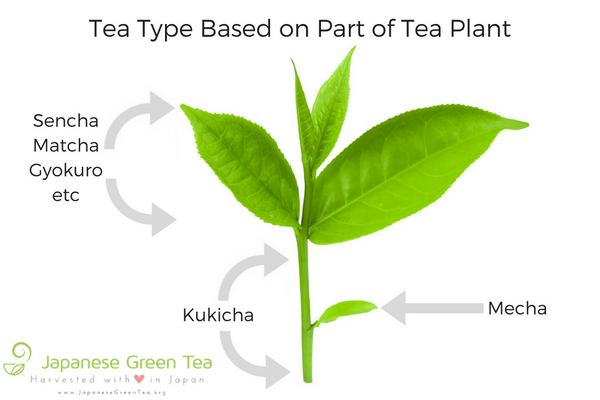
-
Mecha : 芽茶
Me-cha tea, which is translated as “bud tea”, is a type of green tea that is made from the early leaf buds of the green tea plant, which are separated during gyokuro and sencha processing. This allows me-cha tea to be of the same quality as both gyokuro and sencha teas at a fraction of the price. Another benefit of me-cha tea is that it can be re-steeped multiple times while still retaining its full flavor. Me-cha tea is a popular after-dinner drink as it works especially well to cleanse the palate due to its strong, bitter aftertaste.
Steeping Suggestion: 2 teaspoon - 90°C (195°F) - 40 sec. - 365 ml (8oz)
Back To Top
-
Kuki-cha (Twig Tea): 茎茶
Kuki-cha, also known as bocha, is made from the twigs and stems of the Camellia sinensis. It is translated as “twig tea” and can usually be found in the form of green tea; it is also sold in more oxidized forms. Kuki-cha tea has a unique sweet and nutty flavor. It is highly sought after for its health benefits and is especially popular in the macrobiotic diet community. Those that follow the macrobiotic diet eat a lot of whole foods that are unprocessed. Since Kuki-cha tea is comprised of the stems of the plant, it is also full of the minerals and vitamins that feed the plant. Some of the more essential minerals found in this tea include calcium, copper, zinc, selenium, manganese, and fluoride. Like other green teas, it is also filled with antioxidants, including vitamin A, B-complex, and vitamin C. This helps protect the body against a myriad of diseases including several types of cancers. Kuki-cha is also naturally very low in caffeine, making it a good option for children.
Steeping Suggestion: 2 teaspoon - 90°C (195°F) - 40 sec. - 365 ml (8oz)
Back To Top
-
Aracha (Crude Tea) : 荒茶
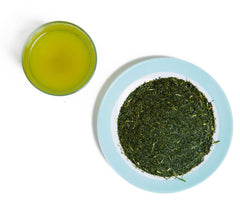

Aracha translates to "wild tea" in English. Aracha is green tea where the process of green tea keeps the original shape as it is cropped. Most of the green tea that is consumed is refined and processed green tea. In Japan, however, green tea is usually sold from the farmer to a wholesaler who then processes and refines the tea. When green tea is provided to the wholesaler, the form of the green tea is usually Aracha where it has not been processed yet. This type of green tea is usually not distributed to consumers. However, some fans prefer drinking this type so that they can enjoy the rich and natural taste and flavor.
Steeping Suggestion: 2 teaspoon - 90°C (195°F) - 40 sec. - 365 ml (8oz)
Back To Top
Tea Type Based on Covering Process
Few types of the Japanese green tea go through the process of covering the tea plant before harvesting. This type of tea includes the popular types of matcha and gyokuro which were mentioned previously. There are different commonly known type of covered green tea which differ based on the processing method. Below is a list of tea types related to covering tea.
 By purposely blocking sunlight for a few days before new sprout grow, the tea creates a very unique aroma and taste.
By purposely blocking sunlight for a few days before new sprout grow, the tea creates a very unique aroma and taste.
 Due to the special net blocking sunlight, the tea leaves increase chlorophyll, making the color of the tea a darker green. Tea made from such leaves create a beautiful emerald green color which is rare to see in other types of green tea.
Due to the special net blocking sunlight, the tea leaves increase chlorophyll, making the color of the tea a darker green. Tea made from such leaves create a beautiful emerald green color which is rare to see in other types of green tea.
-
Kabuse-cha (Covered Green Tea):被せ茶


Kabuse-cha translates as "covered green tea" in English. The green tea is covered by a special net to block sunlight for a few days before new sprout grow. By purposely blocking sunlight for timed few days before new sprout comes out, the tea creates a very unique aroma and taste.
Covered tea usually takes less time than gyokuro tea, usually 1/2 of the time.
Steeping Suggestion: 2 teaspoon - 70°C (175°F) - 90 sec. - 365 ml (8oz)
Back To Top
-
Tencha : 碾茶
Tencha tea is translated as “ground tea” because it is frequently ground up to produce the fine powder for matcha tea. Like gyokuro , it is a high-quality green tea because it is produced in much the same way. Like gyokuro , tencha leaves are also shaded, which gives it its smooth flavor and large amount of nutrients. The main difference between the two is that gyokuro leaves are rolled compared to tencha leaves are laid out flat to air-dry and then are deveined and destemmed. This is so that the leaves can easily be ground to make matcha tea if so desired. Tencha tea has a unique flavor, unlike both gyokuro and matcha, that is very smooth. It also has a mellow fragrance with a mild sweetness. When preparing tencha tea, you will want to use twice the amount of tea leaves you would use for gyokuro because tencha leaves are lighter. You may also have to press the tea leaves down into the water, so they are fully saturated due to their light weight.
Steeping Suggestion: 2 teaspoon - 70°C (175°F) - 90 sec. - 365 ml (8oz)
Back To Top
-
Koicha : 濃茶
Koicha is a thick, syrupy mixture with a consistency that is similar to honey or melted chocolate. Koicha contains a lot of flavor because the tea is a product of harvested green tea plants that are over thirty years old. At this age, the leaves are at their peak flavor. Koicha is naturally sweet and has a vibrant green color. This tea also has a powerful flavor and smell that is much different than other Japanese green teas. Since koicha is so concentrated, you should mix it with a high-quality matcha to cut down on bitterness and improve the flavor. Given its flavor, inexperienced green tea drinkers may need some time to adjust to the intense flavor of koicha. Koicha has long been the traditional choice for Japanese tea ceremonies although usucha is becoming the norm today. A bowl of koicha is typically shared among several people who take turns drinking.
Steeping Suggestion: 2 teaspoon - 80°C (185°F) - until dissolved - 365 ml (8oz)
Back To Top
-
Usucha : 薄茶
Thin matcha, also called usucha, is made by brewing tea with more water and a smaller amount of powder. Usacha is also a ceremonial Japanese tea that is instantly recognizable for its frothy top, which forms from intense whisking. Usucha reminds some people of lattés, which also have a frothy head. Usucha tea has a strong flavor, though it is typically made from younger tea plants. Usucha is the standard for everyday matcha blends. The brew is foamy and sweet, with subtle umami undertones. With both koicha and usucha, you will never want to prepare eaithe tea with boiling water. Rather, the best temperature is 176 degrees Fahrenheit. If the water is too hot, it can give the matcha a bitter taste. Usucha needs about one-quarter of the amount of matcha that koicha requires. Since koicha uses high-grade matcha, it's considered to be a more indulgent and expensive choice for tea ceremonies. Therefore, people have started using more affordable matcha, which has led to usucha's surge in popularity.
Steeping Suggestion: 2 teaspoon - 80°C (185°F) - until dissolved - 365 ml (8oz)
Back To Top
Tea Type Based on Season of Crop
There are different names of tea based on when the teas are cropped. The tea crop season usually starts around April to June and continues until winter. Depending on when the crop is picked, there are different name denoting the tea. Here are few popularly heard name of tea based on season.

-
Ichiban-cha (First Crop Tea):一番茶
In Japan, green teas are categorized as first, second, and third based on when the tea is being harvested. The first harvest of the season is called Ichiban-cha. This is also called "new crop" (or Shin-cha). Since it is the first harvest, this is referred as "syun", or seasonable. (Japanese culture value the concept of "syun" (seasonable), and example of it is famous haiku where it must use a word of season "syun" in the short poem.) The characteristic of the first harvest is that the tea leaves are still "young" so their age brings a richer and clearer aroma. It is also called Shin-cha or Shincha.
Steeping Suggestion: 2 teaspoon - 70°C (175°F) - 90 sec. - 365 ml (8oz)
Back To Top
-
Shin-cha: 新茶
This is another way of saying Ichiban-cha mentioned above; it translates in English as "new tea".
Steeping Suggestion: 2 teaspoon - 70°C (175°F) - 90 sec. - 365 ml (8oz)
Back To Top
-
Niban-cha: 二番茶
Second crop tea is called niban-cha. "Ni" refers to number 2 in Japanese. Nibancha is cropped usually after 45-50 days after first crop (ichiban-cha) which is between June to July in the usual year.
Steeping Suggestion: 2 teaspoon - 70°C (175°F) - 90 sec. - 365 ml (8oz)
Back To Top
-
Sanban-cha: 三番茶
Third crop tea is called sanban-cha. "San" refers to number 3 in Japanese. Sanbancha is cropped usually after one month after the second crop (niban-cha).
Steeping Suggestion: 2 teaspoon - 100°C (212°F) - 30 sec. - 365 ml (8oz)
Back To Top
-
Bancha (Coarse Tea): 番茶
Ban means "late" in Japanese. When tea is harvested later in the year making the leave to be larger and mature, it is called Bancha. Bancha is harvested between Summer and Autumn. Bancha is usually considered lower grade and provides lower market value in Japan.
Steeping Suggestion: 2 teaspoon - 100°C (212°F) - 30 sec. - 365 ml (8oz)
Back To Top
Tea Type of Powder Tea
There are other powdered Japanese teas besides matcha. Here are couple of well-known powdered Japanese green tea.
-
Kona-cha : 粉茶
Kona-cha, which literally means “powder tea”, is a by-product of the production of gyokuro or sencha tea. Instead of wasting useful parts of the plant that go unused in the making of other teas, kona-cha tea utilizes this fine dust that is composed of the buds and finely chopped tea leaves which allows kona-cha to be sold at a much cheaper price. Since it is composed of a fine dust, kona-cha tea is a fuller-bodied tea with a deep green color. It has a mild, sweet grassy flavor and is often used in cooking. It is frequently served at sushi restaurants.
Steeping Suggestion: 2 teaspoon - 80°C (185°F) - until dissolved - 365 ml (8oz)
Back To Top
-
Funmatsucha:粉末茶
Funmatsucha tea is similar to kona-cha, but instead of small bits of leaves, it comes in the form of a powder. One of its advantages is that it can be used to make instant tea. For example, as opposed to steeping the tea leaves, you merely have to mix the powder directly into your hot water. This allows you to receive a larger portion of the compounds found in the tea such as caffeine. Funmatsucha is sometimes confused with matcha tea because of its similar color and texture; however, its leaves are not shaded from the sun like matcha. Since it undergoes additional photosynthesis, funmatsucha tea takes on a more bitter taste. It still contains the same amount, or possibly even more, antioxidants than other green teas.
Steeping Suggestion: 2 teaspoon - 80°C (185°F) - until dissolved - 365 ml (8oz)
Back To Top
Tea Type Based on Length of Steaming
Depending on how long green tea is steamed, the duration also changes the characteristic of the tea. Other than "normal" steaming length which is about 30 - 40 seconds, there are different names associated with how long the steaming process is compared to the "normal".
-
Fukamushi-cha (Deep Steam Tea):深蒸し茶
Fukamushi translates to "deeper steam" in Japanese. This approach only works well for thicker tea leaves. In order to take advantage of richer nutrients contained in thicker tea leaves, they are steamed for three to four times longer than regular sencha green tea. All of our green tea are of this type. In contrast, when the tea is lightly steamed, it is referred to as Asamushi-cha.
Steeping Suggestion: 2 teaspoon - 90°C (195°F) - 30 sec. - 365 ml (8oz)
Back To Top
Read in-depth article about Deep Steaming Tea here.
-
Asamushi-cha (Light Steam Tea): 浅蒸し茶
Compared to "normal" steaming process, asamuchi-cha is steamed less. If the length is about 20 seconds, it is also considered GokuAsamuchi 極 浅蒸し. The word "Goku" translates to "extreme" in English so it means “extremely lightly steamed tea”. This kind of tea tends to have more of the flavor of the tea itself and has more astringency and bitterness. Teas grown in valley area are considered good for this type of steaming due to not getting much of sun exposure.
Steeping Suggestion: 2 teaspoon - 70°C (175°F) - 90 sec. - 365 ml (8oz)
Back To Top
-
Futsumuch or Namamushi (Medium Steamed Tea): 普通蒸し、中蒸し
The tea steamed for the "normal" length of time, i.e., 30 - 40 seconds, are considered Futsumushi or Nakamushi which translates to "normal" or "middle". You do not hear this often as most of Japanese green tea sencha are of this type.
Steeping Suggestion: 2 teaspoon - 70°C (175°F) - 90 sec. - 365 ml (8oz)
Back To Top
Tea Type Based on Oxidization Level
Most teas are from the Camellia sinensis plant, including black tea from Europe. Japanese Green Teas like sencha or matcha are not oxidized, but based on oxidization level, the tea becomes different tea. Below are common (and popular) oxidized teas that are sold and in Japan.
Oxdization Level - Light
-
Pu-Erh Tea (Microbial fermentation tea):プーアル茶


Pu-Erh tea is made by steaming and fermenting freshly cut tea leaves. Traditionally, Pu-Erh tea was consumed by ethnic minorities in China, Tibet, Mongolia, and other Southeast Asian regions. The name, Pu-Erh, comes from a town called Pu-erh in the Yunnan district of China where it was stocked for trading. Our Japanese Pu-Erh tea use quality, fresh green tea and go through a careful fermentation process.
Back To Top
Oxdization Level - Medium
-
Oolong cha: 烏龍茶
Oolong cha tea is very unique because it is partially fermented. While black teas are fully oxidized and most green teas are not, oolong tea falls somewhere in the middle. Depending on who cultivates it, the level of oxidation for oolong cha tea can fluctuate anywhere from eight to eighty percent, causing the flavor to vary greatly from light to full-bodied. Along with the many health benefits of tea, fermented drinks and foods come with their own unique attributes such as improving gut health. While oolong teas have been popular in Eastern cultures for many centuries, they have just recently become more common in the United States.
Back To Top
Oxdization level - High
-
Black Tea: 紅茶
European black tea, which is popular worldwide, is product of higher fermentation from original tea plant. We do not go into much here as there is a lot more detail about the different types of black tea throughout the world. In Japan, this type is not called black; rather it is called red tea (kou-cha 紅茶)
Back To Top
Tea Type Based on Location of Farm
The names of various teas could also be categorized based on where the tea was cropped. Below are the most well-known names; however, there are many more.
-
Uji Cha :宇治茶
Tea cropped in Uji Kyoto. Well-known for historical tea as Uji is known to be the origin of tea history. Kyoto ranks #5 in the volume of Japan's production of tea.
Back To Top
-
Shizuoka Cha:静岡茶
Shizuoka crops 5% of the total tea crop of Japan and considered tea capital of Japan.
Back To Top
-
Kawane Cha : 川根茶
Part of Shizuoka prefecture grown in the mountainous area.
Back To Top
-
Kagoshima Cha:鹿児島茶
Kagoshima ranks #2 in terms of the production of Japan's tea after Shizuoka. It is known to be produced in wide open area. Famous tea made in Kagoshima is known as Chiran-cha 知覧茶
Back To Top
-
Ise Cha: 伊勢茶
Tea produced in Mie prefecture is known to be called Ise-cha; “Ise” is old name of the area. Mie ranks as #3 in terms of the production of tea in Japan.
Back To Top
-
Sayamacha:狭山茶
Tea produced in Sayama, Saitama which is prefecture next to Tokyo. There are well-known words about tea in Japan. The best color of the tea is from Shizuoka, aroma from Kyoto, and taste from Sayama.
“色は静岡、香りは宇治よ、味は狭山でとどめさす” . Depending on the areas, they are known to put more "fire" at the end of processing called Hiire (火入れ) which makes the tea dryer and sweeter.
Back To Top
-
Minou-cha :美濃茶
Tea produced in Gifu prefecture, known to have distinct taste due to high altitude geographical area.
Back To Top
Tea Type Based on Cultivar
The cultivar is the variety of the tea plant. Although all tea is of Camellia Sinensis, there are the different variety which is selected by tea farmer or region. Most of the Japanese green tea you find are of type Yabukita but there are more than 50 different types of cultivars exists in Japan.
-
Yabukita : やぶきた


The most popular cultivar in Japan; 77% of the Japanese tea field produces this cultivar.
Back To Top
-
Benifuuki:べにふうき


Benifuuki tea is a cultivar of the tea plant that was cross-bred between the varieties Assamica and Sinensis in 1965 in Makurazaki City, Kagoshima, Japan. This cultivar is known to be good for relief.
Other Very Popular Japanese Tea Types
-
Genmai-cha: 玄米茶
Genmai-cha is a very unique green tea because the sencha tea leaves are blended with roasted brown rice. It is also known as popcorn tea because the kernels of rice sometimes pop during the roasting process. This distinctive drink was initially used by monks as a form of conservation. They would add the rice stuck to the bottom of their pan to the green tea to help their tea supplies last longer. This drink has a rich, nutty flavor that is both sweet and earthy. While unlike any other form of green tea, it has a very comforting appeal similar to that of soup broth. It has become a favorite among the Japanese.
Steeping Suggestion: 2 teaspoon - 100°C (212°F) - 30 sec. - 365 ml (8oz)
Back To Top
-
Houji-chaほうじ茶
Houji-cha tea is typically produced from sencha tea. What makes it distinctive from other green teas is that it is roasted instead of steamed, causing it to be very low in caffeine. This makes houjicha a popular after-dinner drink. It is so mild, it can even be served right before bed. It is also frequently given to both infants and the sick because of its nourishing attributes and minimal caffeine. The roasting gives the tea its characteristic roasted nut flavor that is very popular.
Steeping Suggestion: 2 teaspoon - 100°C (212°F) - 30 sec. - 365 ml (8oz)
Back To Top
-
Guricha (AKA tamaryokucha): ぐり茶 玉緑茶
Guricha tea means “curly tea” and is also sometimes referred to as tamaryokucha, which is translated as “coiled tea”. This very rare tea makes up only five percent of the total tea produced in Japan. What makes it so unique is that during the production of guricha tea, the final kneading process is skipped. When it dries, the leaves are in the shape of a comma, giving it its name. Due to its unique processing method, guricha tea has a very sweet, fruity flavor. It is a true delicacy that should not be missed.
Steeping Suggestion: 2 teaspoon - 100°C (212°F) - 30 sec. - 365 ml (8oz)
Back To Top
-
Kamairicha : 釜炒り茶
Kamairi-cha is unique in that it is not steamed. Rather, it is pan-fried. This tea has a mild, roasted flavor and a dainty aroma. The pan-frying method originated in China during the Ming dynasty, but today, it is the preferred method for halting tea leaf oxidation. The pan-frying technique was brought to the Japanese islands in the fifteenth century. Eventually, Japan ended up adopting the steaming method later on, so the pan-frying method is quite rare nowadays. This is an incredibly special tea, with an unbelievably smooth and rich flavor. Kamairi-cha accounts for only 2% of all Japanese tea and is even harder to come by in the west. Hojicha, another type of Japanese tea, is also prepared with the pan-frying method. Hojicha is mostly made from stalks that are pulled out during mechanical harvesting. Hojicha is a no-fuss tea that is suitable for everyday drinking. Historically, it was known as the tea of the common people and was largely consumed by farmers.
Steeping Suggestion: 2 teaspoon - 70°C (175°F) - 90 sec. - 365 ml (8oz)
Back To Top -
Kuradashicha : 蔵出し茶
Almost every Japanese tea lover is familiar with kuradashi-cha. Kuradashi-cha is a spring tea made from only the highest quality tea leaves that are processed and stored in airtight canisters. The leaves are left to age until the autumn season, usually inside of temperature-controlled repositories. This aging process breaks down certain compounds in the leaves that cause tightening and puckering sensations in the mouth when consumed. At the end of the process, which can last three months to several years, the flavor is well-rounded and pleasant.
Steeping Suggestion: 2 teaspoon - 70°C (175°F) - 90 sec. - 365 ml (8oz)
Back To Top -
Yanagi : やなぎ
During the process of making sencha, another Japanese green tea, some leaves inevitably fall out during rolling. These leaves are flat and folded, resembling willow leaves which is how yanagi gets its name (yanagi is Japanese for willow). The larger leaves also attribute to yanagi’s pale green color. Yanagi has a less tart taste than sencha and is light-bodied. Many people like to drink yanagi between or after meals since it is not heavy or filling. Since yanagi leaves tend to be large, you’ll want to make sure to use an adequately-sized teapot and cup to enjoy this tea. Yanagi is made in the spring and its flavor has been compared to steamed leafy vegetables.
Steeping Suggestion: 2 teaspoon - 70°C (175°F) - 90 sec. - 365 ml (8oz)
Back To Top -
Umecha: 梅茶
A plum tea. Most of the time, umecha refer to pouring green tea over umeboshi which is pickled salted plum. Often times, umecha refer to Ume-kombucha. It is not tea made out of leaf of plum. Plum tea is also traditional Korean tea which is made out of pickled plum fruit soaked in honey. It tastes more like plum juice than it does tea.
Steeping Suggestion: 2 teaspoon - 70°C (175°F) - 90 sec. - 365 ml (8oz)
Back To Top -
Umekonbucha: 梅昆布茶
A mixture of Konbucha with dried plum fruit. Kombucha with powdered, freeze dried plum is known as Fukucha; it’s used for cerebrations such as for the new year.
Steeping Suggestion: 2 teaspoon - 70°C (175°F) - 90 sec. - 365 ml (8oz)
Back To Top -
Fukucha: 副茶
A tea that is drank in cerebrating occasion such as the new year, end of the year (omisoka), and Setsubun (the day before the beginning of Spring). This is occasion practiced in Kyoto and west of Japan since 12th century. Uses black bean, Konbu, Umeboshi together with sencha; soy beans are used for the Setsubun.
Steeping Suggestion: 2 teaspoon - 70°C (175°F) - 90 sec. - 365 ml (8oz)
Back To Top
Non-Camellia Sinensis Tea
There are popular tea in Japan which are made out of plants that are not Camellia sinensis plant. (Camellia sinensis are plants commonly known as "tea plant")
Following are some popular Japanese tea which are not from "tea plant".
-
Mugicha : 麦茶
Mugicha is actually not made of tea leaves. Rather, it is made by simmering roasted barley grains. Mugicha is popular as a cold drink in many Japanese restaurants in the summertime because of its summery taste and bitter undertones. However, many people find it to be less bitter than tea made from leaves. To some, mugicha is more refreshing than plain water on a warm day. Mugicha is sold in three varieties. The most traditional style is loose, roasted barley grains; it will have a dark brown color. The second variety comes in the form of tea bags for cold brewing; it is the most popular way to buy mugicha. Lastly, there are hybrid tea bags that can be simmered or served as a cold brew. Mugicha is a delicious alternative to over-sweetened, sticky iced tea beverages.
Back To Top
-
Sobacha : そば茶
Like mugicha, soba-cha is not made from tea leaves. Instead, it is made from roasted buckwheat. It is caffeine-free and has a nutty taste and aroma, so the flavor pairs well with both sweet and savory foods. Soba-cha, often referred to as “buckwheat tea”, can be served hot or cold. To prepare the tea, husked buckwheat is pan-fried without oil and infused with hot water for two to four minutes. This tea is very popular due to its sweet taste and toasty fragrance. The natural sugar within the buckwheat caramelizes as it’s heated, producing a naturally sugared beverage. The buckwheat can be saved after brewing your tea and added to oatmeal for an extra sweet, toasty flavor.
Back To Top
-
Gobocha : ごぼう茶
Gobo-cha is made from burdock root. It’s popular in Japan as a healthy tea and is also used in China to relieve medical ailments. Burdock root is available year-round, however, peak season is summer through fall. The root has a very earthy flavor and is often soaked in water with lemon or vinegar as part of processing to remove any astringent taste. Gobo-cha drinkers have noted that it is an acquired taste, due to its natural and unfussy flavor profile.
Back To Top
-
Konbucha : 昆布茶
Konbu-cha is not to be confused with Kombucha, a popular tea drink in the United States. Kombucha is a fermented black or green tea beverage that is somewhat alcoholic. It's often enjoyed for its alleged health benefits. Konbu-cha, on the other hand, contains no tea leaves. Instead, it is made from soaking seaweed kelp in hot water. It is enjoyed as a tea, and also as a flavoring in cooking. Konbu-cha has a strong umami flavor and is renowned for being very delicious. Some people describe it as being slightly salty. Though seaweed is an important staple of Japanese cuisine, people from other areas of the world often don’t realize how many different ways seaweed can be consumed.
Back To Top
-
Genpicha : 原肥茶
Genpi-cha is a tea blend made from ten varieties of plants. All of the flavors are quite mild, coming together to make one delicious, easily drinkable tea. Some people add water to this tea as they drink it because the flavor can change and become stronger as it sits. Citrus, psyllium seed, and oolong tea are just a few of the elements infused into this tea. Genpi-cha is non-caffeinated and is very popular amongst Pinterest users and food bloggers.
Back To Top
Tea Names From Tea Product Sold by Major Corporations
There are many companies producing bottled or canned green tea in Japan. This is because Japan has the highest number of vending machines selling tea in the world.People sometimes get confused that the name of product produced by these companies with a type of Japanese green tea. While these are great teas that I also drink when I am in Japan, they’re not really a “type” of green tea. Here are some that are often confused as type of green tea.
-
Oi-ocha おーいお茶
Japan’s bestselling vending machine green tea produced by Ito-En. They carry different types of green tea under the name of this brand such as Sencha, Koicha, Hojicha, etc.
Back To Top
-
Sokenbicha 爽健美茶
Produced by brand of Ayataka which is under the arm of Coca-Cola company. Some of Sokenbicha’s brews are green and oolong teas, along with other barley teas that contain no actual tea leaves.
Back To Top
-
Gogo no Kocha 午後の紅茶
This is long-seller from Kirin company which was introduced in 1986. Kocha is black tea and is the best-selling black tea beverage in Japan.
Back To Top
-
Nama-cha 生茶
Kirin’s green tea brand. It is famous for is cloudier green tea color compared to other brands.
Back To Top

Related Articles You May Be Interested In
Get Free Bonus Content
If you have ever thought that Green Tea is an “acquired taste” or that it is “too bitter” to enjoy, we’re here to change your mind! We want everyone to experience the health benefits of Green Tea and show you that this can be an amazing, refreshing, and delicious drink when made correctly. With just a few tips on how to brew this powerful leaf we can change your mind about the taste and enjoyment of drinking Green Tea.
Don’t miss out on the health benefits of tea!
- Improve health
- Increase brain function
- Regulate weight
- Lower your risk of cancers
- Reduce risk of heart disease
- Lowers risk of diabetes
We know that you will love this tips to brewing tea and getting the most flavor and elegance out of every cup. Sign up for Free Japanese Green Tea Club and get this great informative manual on brewing green tea. You will learn what it is that makes it one of the most popular beverages in the world.
The E-Book also includes the chapter of Kei Nishida's book, "Art of Brewing Japanese Green Tea" where he teaches you how to brew hot and cold Japanese Green Tea.
Get Free Download
If you have ever thought that Green Tea is an ìacquired tasteî or that it is ìtoo bitterî to enjoy, weíre here to change your mind! We want everyone to experience the health benefits of Green Tea and show you that this can be an amazing, refreshing, and delicious drink when made correctly. With just a few tips on how to brew this powerful leaf, we can change your mind about the taste and enjoyment of drinking Green Tea.
Donít miss out on the health benefits of tea!
- Improve health
- Increase brain function
- Regulate weight
- Lower your risk of cancers
- Reduce risk of heart disease
- Lowers risk of diabetes
We know that you will love this tips to brewing tea and getting the most flavor and elegance out of every cup. Sign up for our newsletter and get this great informative manual on brewing green tea. You will learn what it is that makes it one of the most popular beverages in the world.
The E-Book also includes the chapter of Kei Nishida's book, "Art of Brewing Japanese Green Tea" where he teaches you how to brew hot and cold Japanese Green Tea.
Also in Japanese Green Tea Lovers in India
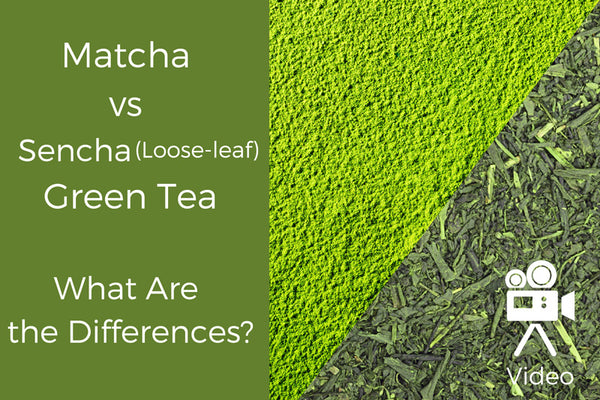
TYPES OF TEA: MATCHA VS SENCHA GREEN TEA: WHAT ARE THE DIFFERENCES?
When it comes to different types of tea, matcha and sencha green tea are two many people have questions about! Get answers in this post.
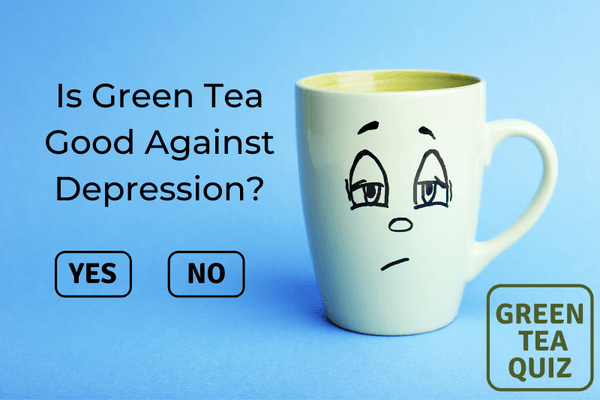
Is Green Tea Good Against Depression?
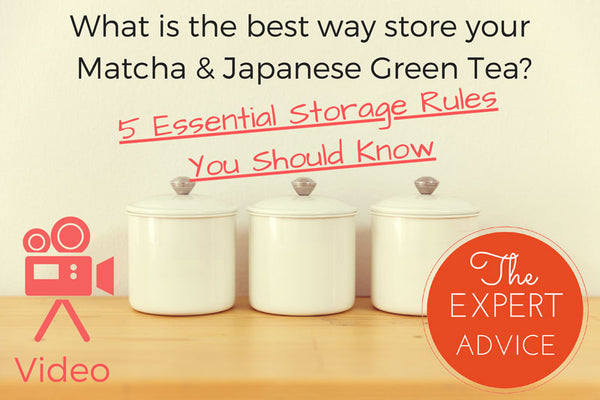
What is the best way to store your matcha & Japanese green tea?
5 Essential Storage Rules for Matcha and Japanese Green Tea
Read on to learn how to store matcha the proper way to ensure that you get the most out of this ancient elixir.


